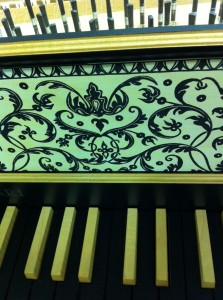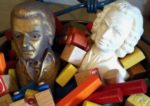Playing With Wolfgang: Harpsichording with Rameau & Couperin
 I remember clearly my first meeting with a harpsichord. I was in my first semester of music history and my assigned presentation was to demonstrate French harpsichord music for the class. My piano teacher was friends with Howard Ferguson and was excited to introduce me to the instrument and to Rameau and Couperin.
I remember clearly my first meeting with a harpsichord. I was in my first semester of music history and my assigned presentation was to demonstrate French harpsichord music for the class. My piano teacher was friends with Howard Ferguson and was excited to introduce me to the instrument and to Rameau and Couperin.
The harpsichord was in a small room without any windows. All around there were cabinets with dusty object and books on them. The instrument was covered by an embroidered cloth. I felt like a time traveler from the get go.
I remember the smooth, light feel of the keys and the shock of the reverse coloring. And the sound! Yes, I loved every minute of that first meeting. It was magical.
Nearly 10 years later, I was helping a student I’ll call Kenneth prepare for his Arizona Study Program exam. He was in High School and had taken violin his whole life. He had come to the piano recently and was playing a Rondeau by Rameau. Since he was much more mature than most other students at that level, I decided to introduce him to ornamentation. We experimented with basic configurations and decided that he would ornament the piece himself and play it that way at his exam.
Kenneth had a great time with this project and actually chose to ornament the second note in many groups. Since I had given him permission to choose the ornaments and where to place them, I didn’t feel that I could criticize his decisions. To change his decisions seemed to me like emulating the teacher who tells the class they are going to have a discussion and then, after the first person ventures an opinion, comes back with, “No. You’re wrong.” (Yes, this really happened to my daughter in a high school English class)
There were lots of years ahead for Kenneth to discover other ways of doing things. So, we left it his way. Well, when I got the sheet giving me the information about the audition and the judge I nearly fainted. The judge was none other than James Anthony, a world renowned and highly published and decorated scholar who specialized in early French music.
I was concerned and worried over my decision. The day of the exam Kenneth played very well and earned a Superior. So I didn’t have to worry that he had been penalized for our choice. As I opened the sealed teacher letter, there was still that feeling in the pit of my stomach. Would there be a scolding inside? As I read it, I began to laugh because he had written, ” You have an unusually good sense of Baroque ornamentation.”
Now, 20 years later, I am helping our college students discover the joys of our brand new harpsichord. Needless to say we have been choosing repertoire to show it off and, of course, to learn a thing or two while we are at it. Ours is placed in a large modern room, brightly lit by fluorescent light panels. There are music chairs and stands scattered about, a grand piano, plus a wall full of the latest AV equipment. Yet, despite the ambiance, I still like to think we can do a little time traveling.
Here is a great article from Roslyn Tureck on period instruments and modern performance. Bach—Piano, Harpsichord, or Clavichord?



My harpsichord idol beside Landowska is Elaine Comparone
Check out harpsichord.org